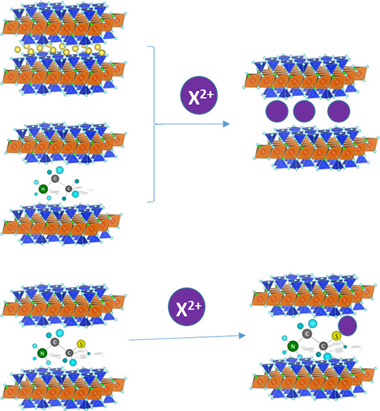Scientific Papers in SCI
2021
2021
Nanotecnología en Superficies y Plasma
Novel procedure for studying laser-surface material interactions during scanning laser ablation cleaning processes on Cu-based alloys
Di Francia, E; Lahoz, R; Neff, D; Rico, V; Nuns, N; Angelini, E; Grassini, SApplied Surface Science, 544 (2021) art. 178820
Show abstract ▽

Laser ablation is an effective method to clean Cu-based alloys. A novel procedure of characterisation was developed involving O-18 isotopes evaluated by ToF-SIMS spectroscopy to assess the driving mechanisms of laser-surface interactions. The presence of re-oxidised compounds was detected, discerning between the oxygen from the corrosion layer and the one introduced by the interaction with the laser (that was generated in a controlled atmosphere of O-18 diluted in N-2). A set of samples treated with different laser conditions were characterised by FESEM and mu Raman. The results have shown that re-oxidation phenomenon can occur and its selectivity depends on the laser conditions.
April, 2021 | DOI: 10.1016/j.apsusc.2020.148820
Nanotecnología en Superficies y Plasma
New Insights on the Conversion Reaction Mechanism in Metal Oxide Electrodes for Sodium-Ion Batteries
Mosa, J; Garcia-Garcia, FJ; Gonzalez-Elipe, AR; Aparicio, MNanomaterials, 11 (2021) 966
Show abstract ▽

Due to the abundance and low cost of exchanged metal, sodium-ion batteries have attracted increasing research attention for the massive energy storage associated with renewable energy sources. Nickel oxide (NiO) thin films have been prepared by magnetron sputtering (MS) deposition under an oblique angle configuration (OAD) and used as electrodes for Na-ion batteries. A systematic chemical, structural and electrochemical analysis of this electrode has been carried out. The electrochemical characterization by galvanostatic charge-discharge cycling and cyclic voltammetry has revealed a certain loss of performance after the initial cycling of the battery. The conversion reaction of NiO with sodium ions during the discharge process to generate sodium oxide and Ni metal has been confirmed by X-ray photoelectron spectra (XPS) and micro-Raman analysis. Likewise, it has been determined that the charging process is not totally reversible, causing a reduction in battery capacity.
April, 2021 | DOI: 10.3390/nano11040966
Fotocatálisis Heterogénea: Aplicaciones
Fluorinated and platinized Titania for Glycerol oxidation
Murcia, J.J.; Bautista, E; Ávila Martínez, E.G.; Rangel R.N.; Romero, R.; Cubillos Lobo, J.A.; Rojas Sarmiento, H.A.; Hernández, J.S.; Cárdenas, O.; Hidalgo, M.C.; Navío, J.A.; Baeza, R.Materials Proceedings, 4 (2021) 37
Show abstract ▽
In this research, photocatalysts based on TiO2 modified by fluorination and platinum addition were evaluated in the glycerol oxidation. These materials were characterized by different instrumental analysis techniques to determine the physicochemical properties. It was found that the surface modification lead to improve the materials absorption in the Visible region of the electromagnetic spectra and to increase the surface area of TiO2. By HPLC analysis was possible to observed that the photocatalysts 0.5% Pt-F-TiO2 showed the highest yield and selectivity towards glyceraldehyde (GAL). It was also observed that the increase in the platinum content until values of 2% had a negative effect in the effectiveness of fluorinated Titania in the glycerol photo-oxidation. The fluorination and platinum addition modify some physicochemical properties of TiO2, leading also to modify the reaction mechanism and selectivity during glycerol partial photo-oxidation and the dose of photocatalysts is an important reaction condition to obtain GAL and Dyhidroxyacetone (DHA) with yields above to 70%.
April, 2021 | DOI: 10.3390/IOCN2020-07792
Materiales Coloidales
Holmium phosphate nanoparticles as negative contrast agents for high-field magnetic resonance imaging: Synthesis, magnetic relaxivity study and in vivo evaluation
Gomez-Gonzalez, E; Caro, C; Martinez-Gutierrez, D; Garcia-Martin, ML; Ocana, M; Becerro, AIJournal of Colloid and Interface Science, 587 (2021) 131-140
Show abstract ▽

The increasing use of high magnetic fields in magnetic resonance imaging (MRI) scanners demands new contrast agents, since those used in low field instruments are not effective at high fields. In this paper, we report the synthesis of a negative MRI contrast agent consisting of HoPO4 nanoparticles (NPs). Three different sizes (27 nm, 48 nm and 80 nm) of cube-shaped NPs were obtained by homogeneous precipitation in polyol medium and then coated with poly(acrylic) acid (PAA) to obtain stable colloidal suspensions of HoPO4@PAA NPs in physiological medium (PBS). The transverse relaxivity (r2) of aqueous suspensions of the resulting NPs was evaluated at both 1.44 T and 9.4 T. A positive correlation between r2 values and field strength as well as between r2 values and particle size at both magnetic field strengths was found although this correlation failed for the biggest NPs at 9.4 T, likely due to certain particles aggregation inside the magnet. The highest r2 value (489.91 mM-1s−1) was found for the 48 nm NPs at 9.4 T. Toxicity studies demonstrated that the latter NPs exhibited low toxicity to living systems. Finally, in vivo studies demonstrated that HoPO4@PAA NPs could be a great platform for next-generation T2-weighted MRI contrast agents at high magnetic field.
April, 2021 | DOI: 10.1016/j.jcis.2020.11.119
Materiales de Diseño para la Energía y Medioambiente
Pb2+, Cd2+ and Hg2+ removal by designed functionalized swelling high-charged micas
Osuna, FJ; Pavon, E; Alba, MDScience of The Total Environment, 764 (2021) 142811
Show abstract ▽

The increasing accumulation of toxic heavy metals in the environment has generated the need of efficient removal systems, being the adsorption method the most popular one applied in aqueous solutions. Of particular concern is the case of Pb2+, Cd2+ and Hg2+ due to their high potential hazard. In this paper, we describe the feasibility of a new family of nanomaterials, swelling high charge micas, in the removal of these cations from aqueous solutions. Batch adsorption experiments were carried out in the as-made micas, NaMn, and after functionalization with ethylammonium, EA-Mn, and mercaptoethylammonium, MEA-Mn. The results have demonstrated that all of them are efficient heavy metal adsorbents, being Na-M2 the best adsorbent for Pb2+ and Cd2+, and, MEA-M2 for Hg2+.
April, 2021 | DOI: 10.1016/j.scitotenv.2020.142811
- ‹ previous
- 80 of 410
- next ›














